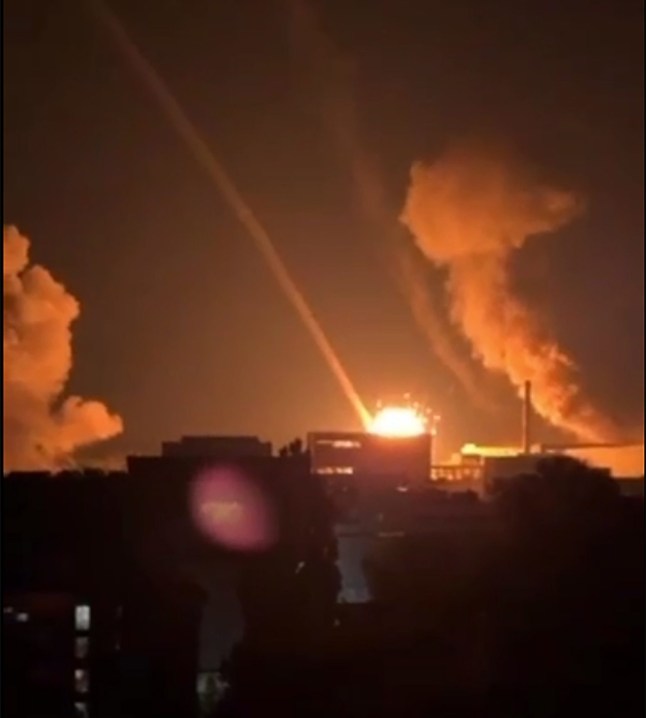Vladimir Putin unleashed a new hypersonic ballistic missile on Ukraine in retaliation for its use of Western weapons to strike Russia.
This morning’s attack, using a mid-range hypersonic Oreshnik missile fired from Russia’s southern Astrakhan region, comes 24 hours after Ukraine deployed US and British missiles on targets inside Russia.
Footage circulating on Telegram channels shows the strike on the central-eastern city of Dnipro, starting at around 5am local time.
Altogether 15 people have been wounded, with two of them teenagers, and nine of them have been taken to hospital.
It was initially feared to be an intercontinental ballistic missile (ICBM), a long-distance weapons designed for nuclear strikes, which hasn’t been used before in war.
Although there was no evidence it carried a nuclear warhead, this would have been a chilling reminder of Russia’s nuclear capability had it been confirmed.
Just two days before, Putin signed a revised nuclear doctrine that formally lowers Russia’s threshold for the use of nuclear weapons.
However, the Russian president has now declared it was an Oreshnik medium-range missile – experimental, but not intercontinental.


Putin claimed it was fired at a Ukrainian military facility in Dnipro, in retaliation for the use of US and British long-range missiles to strike military targets in Russia.
Ukraine’s air force said multiple enterprises and critical infrastructure were targeted.
Putin said: ‘From this moment, as we have repeatedly emphasized, the conflict in Ukraine, previously provoked by the West, acquired elements of a global nature.’
Russia has used drones and missiles provided by Iran and North Korea to strike targets across Ukraine since its full-scale invasion of the country in 2022.
Thousands of North Korean troops have gathered along Russia’s border with Ukraine in recent weeks, with some already engaging in battle.
What is the difference between an ICBM and a mid-range missile?
There are four classes of ballistic missile, based on how far they can travel, according to the Centre for Arms Control and Non-proliferation:
- Short-range missiles, with a range of less than 620 miles, known as a ‘tactical’ ballistic missile
- Medium-range, between 620 miles and 1,860 miles, known as a ‘theatre’ ballistic missile
- Intermediate-range, between 1,860 miles and 3,410 miles
- Long-range, with a minimum of 3,410 miles
A long-range missile can carry a nuclear or conventional warhead from Russia to cities in the US, more than 5,000 miles away.
Ukraine’s air force initially claimed that Russia fired an ICBM along with eight other missiles this morning.
There was no indication that nuclear warheads were used. Had they been, it would have resulted in a much bigger reaction from Ukraine and its Western allies
The air force added in a statement on Telegram: ‘The assault included an ICBM launched from Russia’s Astrakhan region, a Kh-47M2 Kinzhal aeroballistic missile fired from a MiG-31K jet in the Tambov region, and seven Kh-101 cruise missiles launched by Tu-95MS bombers near the Volgograd region.’
ICBM have a range of up to 3,400 miles and can be deployed for delivering nuclear warheads, though they can also have conventional warheads.


Analysis of the wreckage in Dnipro will confirm the exact weapon used by Russia, which claims it was a mid-range missile rather than an ICBM.
Pavel Podvig, director of the Russian Nuclear Forces Project, stressed that this kind of a strike ‘might have a value as a signal’.
He wrote in a thread on X that one must be ‘sceptical and cautious’ about the claims, adding: ‘Regarding the “intercontinental” claim, the distance from Kapustin Yar to Dnipro is about 800 km. It is not an intercontinental range.’
He added later: ‘Using these kinds of missiles, whether RS-26 or a true ICBM, in a conventional role does not make a lot of sense because of their relatively low accuracy and high cost. But this kind of a strike might have a value as a signal.’
Former Russian diplomat Vladimir Frolov also cast doubt about the use of an ICBM in Ukraine.

He stressed that Russian would have to notify the US and China in advance of any launch.
Meanwhile, Richard Gardiner, senior analyst in corporate intelligence at S-RM said a response from the Kremlin in some form was anticipated with the US authorising the use of ATACMS and the UK following suit with Storm Shadow missiles.
The development comes as the full-scale invasion – now in its 33rd month – has taken on a growing international dimension with the arrival of North Korean troops to help Russia on the battlefield.
What is an intercontinental ballistic missile?
An intercontinental ballistic missile (ICBM) is a land-based weapon with a range of at least 3,400 miles.
It is fired into space and then releases a warhead or warheads that re-enter the atmosphere to drop on their targets.
More Trending
ICBMs can carry either nuclear or conventional warheads.
Only the US, Russia and China are currently known to possess missiles of such calibre.
The first ICBM rocket was launched in 1957 by the then-Soviet Union. The US followed in 1959.
According to recent research from the US Congress, Russia has around
1,710 deployed nuclear warheads based on a triad of strategic delivery vehicles roughly consisting of 326 ICBMs, 12 ballistic missile submarines (SSBNs) with 192 submarine-launched ballistic missiles (SLBMs), and 58 strategic bombers.
Got a story? Get in touch with our news team by emailing us at webnews@metro.co.uk. Or you can submit your videos and pictures here.
For more stories like this, check our news page.
Follow Metro.co.uk on Twitter and Facebook for the latest news updates. You can now also get Metro.co.uk articles sent straight to your device. Sign up for our daily push alerts here.
MORE: The Metro daily cartoon by Guy Venables
MORE: Lando Norris admits he wasn’t ready to fight Max Verstappen – and now it’s too late
MORE: ‘This Medik8 serum is my secret to natural radiance – and changed my skincare routine forever’













